Technician Fifth Grade Ervin A. Westendorf
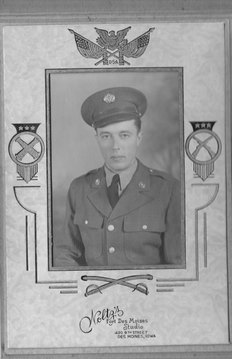
- Unit: 30th Infantry Division, 531st Anti-Aircraft Artillery Automatic Weapons Battalion
- Service Number: 37426166
- Date of Birth: December 5, 1911
- Entered the Military: August 25, 1942
- Date of Death: July 31, 1944
- Hometown: Waverly, Iowa
- Place of Death: Saint-Samson-de-Bonfossé, France
- Award(s): Purple Heart
- Cemetery: Plot H, Row 16, Grave 16. Normandy American Cemetery, Coleville-sur-Mer, France
Mentored by Suzan Turner
Nashua-Plainfield High School
2015-2016
Early Life
Ervin A. Westendorf was born on December 5, 1911, in Waverly, Iowa to Ernest Henry Westendorf and Amelia “Millie” Adeline (Kaiser) Westendorf. He was the sixth of nine children born to the Westendorfs. Sadly, his father died in 1923, leaving Westendorf (age 12) and his siblings at home with their mother, a practical nurse.
Ervin attended Waverly High School, where he played on the football team and graduated in 1931. Unfortunately, only a few years after graduating, tragedy struck again. Westendorf’s older brother, Ernest, died in 1934 after being struck by lightning while working on a farm near Tripoli.
Adulthood
After finishing his formal education, Westendorf found employment on a farm just outside the nearby town of Plainfield. He worked for Buster Lynes, a farmer who raised show cattle entering them in contests to make the mortgage payment on his 80-acre farm. According to Lorraine Chester, the daughter of Buster Lynes, “Dutch” Westendorf was tall, somewhat gawky, and extremely shy, especially around women. Even so, he ended up being as adept as Lynes at raising and showing cattle. After ten years traveling the cattle circuit around the country, Lynes successfully ran for the state Senate. After that, Westendorf found another job in Waverly as a milk tester at the Carnation plant.

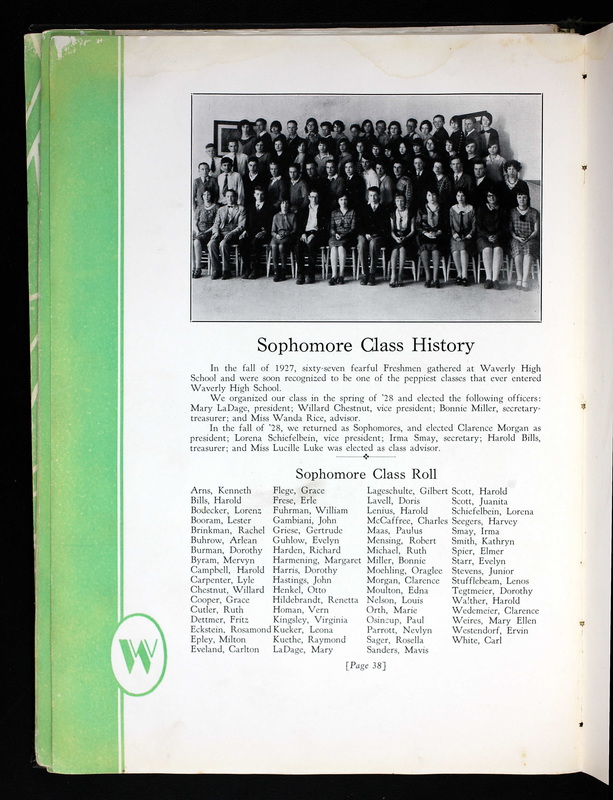
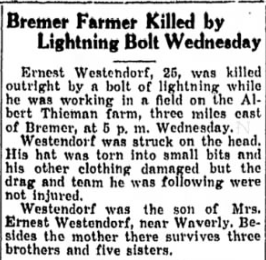
Homefront
At the start of World War II, Waverly, Iowa, was a northeast Iowa agricultural community of just over 4,000 residents and Bremer County’s county seat. In 1941, 261 Bremer county men served in the military, stationed on the Pacific Theatre of Operations from Pearl Harbor to the Philippines. Between December 7, 1941, and January 1942, at least 34 Bremer county men enlisted in the military to support the Allied cause.
Like other communities across the nation, Waverly’s residents supported the war cause by planting victory gardens, buying war bonds, rationing food, collecting scrap metals for wartime armament, and more. Even school children got into the act by writing essays as part of a local newspaper contest based on the theme, “How Sugar Beets Can Help Win the War.” This essay contest encouraged farmers to plant sugar beets to increase sugar production during the war.
Waverly Sugar Company
Sugar was in short supply and was rationed throughout the war. As a result, the Waverly community reopened a sugar factory, which had closed after World War I. At the start of World War II, it employed 25 people, and by the end of the war, it employed 150 people.
The factory made its sugar from sugar beets. Due to a lack of land to grow enough beets, the factory shifted its production to corn syrup under the Wasco label.
The Marshall Canning Company
The Marshall Canning Company played an important role in World War II by packing sweet corn and wax beans for the armed forces. As part of the “Food For Freedom” program, local farms played a significant role in the war effort. In February 1942, the company contracted with local farmers for 2,800 acres of sweet corn. However, they were still short and appealed to the local community’s patriotism through advertising to get the local farmers to cooperate.
Carnation Milk Products Company
Ervin Westerdorf worked at Waverly’s Carnation Milk Products Company before entering the military. The company produced canned milk for the armed services. They held a government contract under the Lend-Lease program with Great Britain, which started in 1941.
Labor
During the war, over 1,300 men and women from Bremer County were called to military duty. However, others left to provide needed labor in manufacturing and the defense industry. Over 100 families moved to nearby Waterloo, Iowa, and other cities for manufacturing jobs and higher wages. This forced many older men, women, and teens to join the workforce and perform jobs essential to wartime production.
Due to a labor shortage, German POWs were brought in to work at the Marshall Canning Company from a POW camp in Algona, Iowa, and were housed at a branch camp in nearby Janesville, Iowa. The 60 prisoners were divided into 20-man shifts that worked around the clock in the factory. In addition to providing industrial labor, they built and moved a grain elevator in Plainfield, Iowa, for J. Roach and Sons when their previous one burned in a fire.

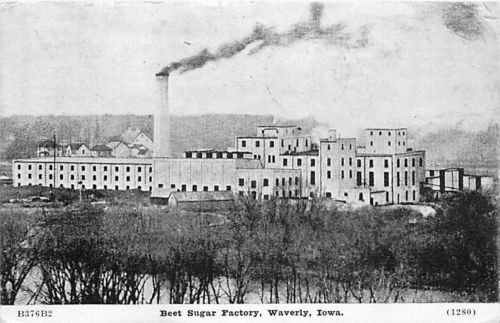
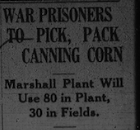
Military Experience
Ervin A. Westendorf completed his Selective Service registration in October 1940. His official military induction and training began on August 25, 1942, when he was 30 years old.
Ervin Westendorf was sent to Fort Bliss, Texas, where he was assigned to the 531st Separate Coast Artillery Battalion (later renamed the 531st Anti-Aircraft Artillery Automatic Weapons Battalion). Later, he advanced his training in California, Virginia, and Massachusetts and then was sent to Fort Remenhan in England.
In February 1944, Westendorf was promoted to Technician 5th Grade. He was assigned to Fire Unit 10, Battery B, providing anti-aircraft protection to other units.
Normandy Campaign
The 531st Anti-Aircraft Artillery Automatic Weapons Battalion departed Weymouth, England, for Omaha Beach, France, on June 15, 1944. Upon arrival, the battalion moved to Isigny-sur-Mer, France, joining the 30th Infantry Division. On July 4, 1944, the unit moved to Lison and then onto Saint-Fromond on July 7, 1944, to protect a bridge under construction by engineers upon the Vire and Taute Canal. Between July 17, 1944, and July 30, 1944, the unit frequently moved to various locations in and around Saint-Lô, including Pont-Hébert, Saint Gilles, Canisy, and Saint-Samson-de-Bonfossé. In Saint-Samson-de-Bonfossé, Westendorf lost his life on July 31, 1944, during a surprise, nighttime air raid.
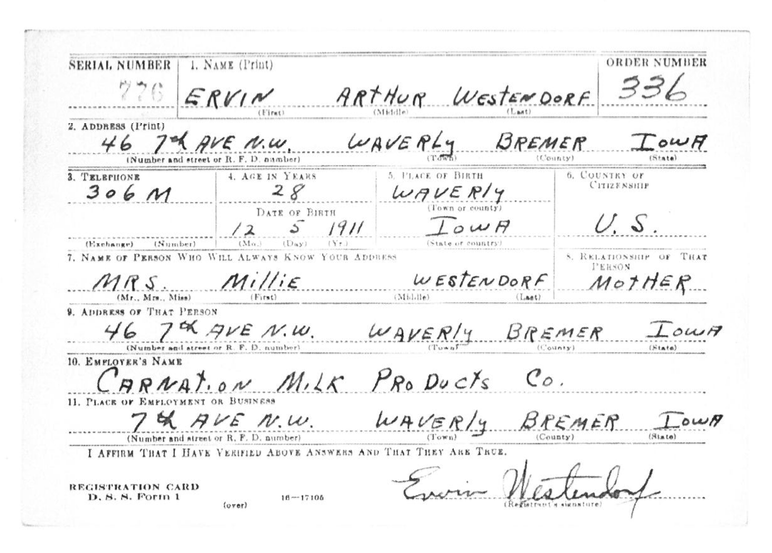


Eulogy
July 31, 1944, had great significance for the Allies in World War II as it marked the date Allied troops successfully broke through German defenses at Saint-Lô on their way to victory in France and later the European Theater. However, it was also a day of great sadness for many American families, as their loved ones, including my Silent Hero, U.S. Army Technician 5th Grade, Ervin A. Westendorf, sacrificed their lives to preserve our freedom. Westendorf’s valiant service and willingness to risk his life for the greater good has enabled me to understand the meaning of sacrifice better.
Ervin A. Westendorf has enabled me to understand that a person can make a difference for the greater good of others, even if it is unrecognized. The actions he took may seem insignificant in the full view of the war, but the motives behind Westendorf’s actions are representative of a true hero. A true hero does not fight to gain a personal advantage over others. Instead, true heroes solemnly stand up for the values that are true to them and the people they are fighting for, even if it means giving up their life in the process.
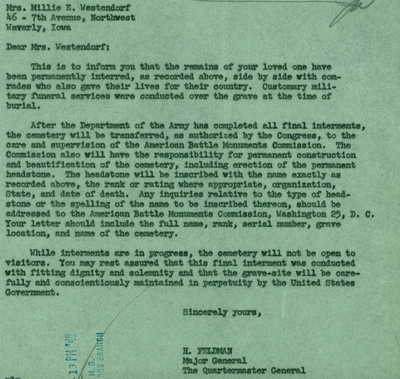
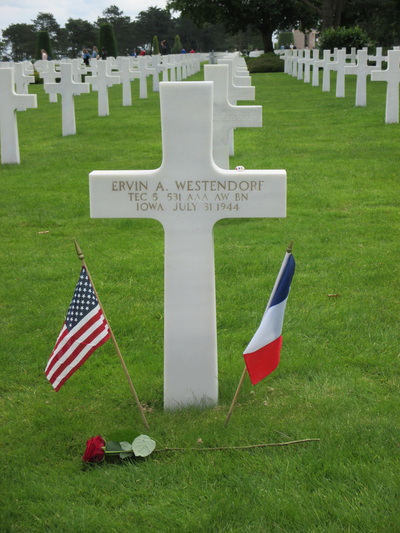
Reflection
Participating in the Normandy: Sacrifice for Freedom Institute was a transformative life experience. The appreciation I have gained for our armed forces, current and past has increased tremendously due to this program, as I now have deepened insight concerning the true meaning of sacrifice. I find it upsetting that most Americans do not understand what our soldiers and their families gave up so that we can experience freedom and tranquility without concern for safety in our everyday lives. Beyond developing a greater personal understanding of sacrifice, this program has caused me to realize that I need to educate others about that sacrifice through my silent hero and others’ story. They died, but their efforts are not forgotten.
This institute provided unforgettable experiences related to my Silent Hero and others. They sacrificed their lives and livelihoods to secure victory during the Battle of Normandy and, ultimately, the European Theater. Visiting the many sites associated with the Battle of Normandy was a very moving experience. Before, I had only read about them. It was a very emotional experience to see them in person from the same perspective as the soldiers who fought in World War II. It significantly changed my understanding of the war. Another significant experience occurred at the National Archives while researching my hero, Technician Ervin A. Westendorf. It was there that I first learned the details of his service in the military and found documents containing previously unknown information about his death. This trip provided me with the needed pieces of Westendorf’s history to complete his story and prepare the eulogy that I read at his gravesite.
Through this experience, I realized the power of telling the stories of the countless individuals who died in service to our country to help others understand sacrifice. The past six months have been life-changing for me. This institute allowed me to view the word sacrifice in a completely different light than I had ever been able to before. I now understand that it was not only U.S. troops who sacrificed everything during the Normandy Invasion. It also required sacrifice from men, women, and children on the home front, the militaries of other Allied countries, and even the French citizens for the invasion to be a success. Thus, I now understand sacrifice in a very personal way that few my age can comprehend, and I want to help others understand this concept on a deeper level. As a result, I look forward to sharing my hero’s story with those around me.
Bibliography
Primary Sources
“34 Leave for Service in the Armed Forces.” Waverly Democrat. August 28, 1942.
531st Coastal Artillery (Automatic Weapons) AA Battalion, Record Group 407 (Box 13980); National Archives at College Park, College Park, MD.
Beet Sugar Factory postcard, Waverly Iowa. Collection of Dr. Terrence Lindell.
“Bremer Farmer Killed by Lightning Bolt Wednesday.” The Sumner Gazette, July 5, 1934.
Chester, Lorraine. Interview with the Author. Telephone interview. May 20, 2016.
“Ervin A. Westendorf.” U.S. WWII Draft Cards Young Men, 1940-1947. National Archives and Records Administration. ancestry.com.
Ervin A. Westendorf Individual Deceased Personnel File. Department of the Army.
Iowa. Waverly County. 1930 U.S. Federal Census. ancestry.com.
Iowa. Waverly County. 1940 U.S. Federal Census. ancestry.com.
“Manpower Needs Food to Win.” Waverly Journal, April 8, 1943, 4.
“Roach Elevator Uses War Prisoners.” Waverly Democrat. October 20, 1944.
“Scrap Drive.” Waverly Democrat, May 6, 1943.
“Sugar Will Help Win the War.” Waverly Democrat. January 9, 1942.
Webster & Stevens. Carnation Milk advertisement. 1944. Museum of History and Industry, Seattle (1983.10.14800.2). digitalcollections.lib.washington.edu/cdm/singleitem/collection/imlsmohai/id/2856.
Secondary Sources
“Ervin A. Westendorf.” American Battle Monuments Commission. Accessed May 8, 2020. www.abmc.gov/decedent-search/westendorf%3Dervin.
“Heart Attack Proves Fatal to State Senator J. Kendall Lynes.” The Greene Recorder. May 9, 1962, 1.
Lindell, Terrence J. “‘Bomb ‘em with Junk’: The 1942 Scrap Metal Campaign in Bremer County, Iowa.” Presentation at the Missouri Valley History Conference, Omaha, Nebraska, March, 2010.
Lindell, Terrence J. “‘Dear Boys’: An Iowa Editor Describes the World War Two Home Front.” Presentation at the Thirtieth Annual Northern Great Plains History Conference, Brandon, Manitoba, Canada, September 29, 1995.
Lindell, Terrence J. “Victory Fever Strikes Northeastern Iowa: Preparations for V-Day, 1944.”
Lindell, Terrence J. “The Waverly Branch Camp and German Prisoners of War, 1944-1945: The View From the Local Press.”
Lindell, Terrence J. “‘We Will Not Turn Back’: A Northeast Iowa Community and the Opening Months of World War II.” Presentation at the 39th Annual Northern Great Plains History Conference, Bismark, North Dakota, October, 2004.
“Ervin A. Westendorf.” Find A Grave. Updated October 8, 2009. Accessed May 8, 2020. www.findagrave.com/cgi-bin/fg.cgi?page=gr&GRid=42856994.
Wieviorka, Olivier. Normandy: The Landings to the Liberation of Paris. Cambridge: Harvard University, 2008.

